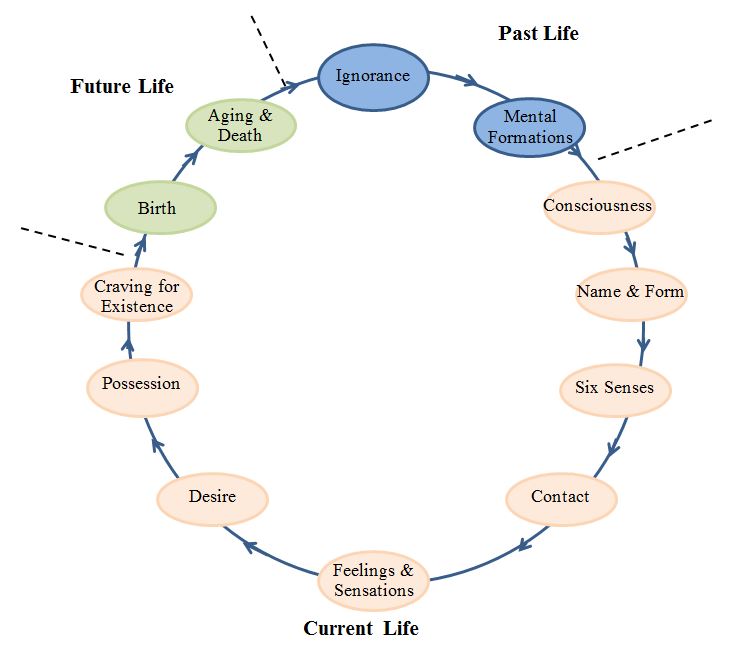The Twelve-Linked Chain of Dependent Origination with my commentary
According to Buddhist tradition, the chain of cause and effect that perpetuates suffering can be described as follows:
From ignorance come formations. From formations comes consciousness. From consciousness come name and form. From name and form come the six sense-fields. From the six sense-fields comes stimulation. From stimulation comes sensation. From sensation comes craving. From craving comes attachment. From attachment comes existence. From becoming comes birth. From birth come old age, death, pain, lamentation, suffering, anxiety, and despair.According to the traditional interpretation within Theravada Buddhism, the first two links in the chain (ignorance and formations) belong to one life, the next eight (consciousness, name and form, the six sense-fields, stimulation, sensation, craving, attachment, and existence) belong to the subsequent life, and the last two links (birth and the various evils that follow from it) belong to a third life. The picture accompanying this post presents this Theravadin interpretation with slightly different wording. Other interpretations can be found in both Theravada and Mahayana. After some thought, the traditional Theravada interpretation described above strikes me as the most straightforward and plausible attempt to figure out what the Buddha meant (not that I have any academic credentials to make such a judgment, of course).
However, the traditional Theravada interpretation is overly rigid when it insists on assigning each link to one of three different sequential lives. I agree with the interpretation that links 1 and 2 represent a life, links 3–10 represent a life, and links 11 and 12 represent a life, yet identifying these as three different lives, one after another, seems like an artificial systematization imposed on the text. Worse yet, this traditional interpretation may suggest, to those new to Buddhist philosophy, that the first life contains only ignorance and formations and that the third life contains only birth and the resulting evils—whereas, of course, every life contains all twelve links.
As I see the list, the links within each life (for example, links 3–10) are in strict chronological order, but the list as a whole is not. Instead, we should divide the list of twelve links into three sub-lists: Sub-List A contains links 1 and 2, Sub-List B contains links 3–10, and Sub-List C contains links 11 and 12. Each sub-list describes an important process that occurs across every life. Within the complete, twelve-step list, the transition from Sub-List A to Sub-List B or from Sub-List B to Sub-List C shows the causal connections between the sub-lists but doesn't mean that each sub-list belongs to a different life.
All the above is a bit abstract, so here is a step-by-step commentary to clarify my interpretation:
From ignorance come formations.Ignorance is the beginning of Sub-List A. Because of our ignorance (for example, our belief in a self), we form intentions ("formations") that generate karma.
From formations comes consciousness.Intentions are the last link of Sub-List A. Consciousness is the first link of Sub-List B. Consciousness is not the first stage of a subsequent life, after the life described in Sub-List A, but, rather, the first stage of any life. Hence, we shouldn't view the transition from formations to consciousness as a transition from a certain life to another, later life. Instead, we should view it as something subtly but crucially different: an expression of the relationship between any two adjacent lives: the consciousness that begins a new life is caused by the karma generated by intentions in previous lives.
From consciousness come name and form.According to Theravadin orthodoxy, consciousness depends on mind and body ("name and form") and cannot survive apart from them for any length of time. (Mahayanists, as well as some non-Theravadin early Buddhist sects, have somewhat different views.) Despite consciousness's dependence on the body, Theravadin scholars say that the beginning of a new life is triggered not by the appearance of a new body but, rather, by the appearance of a moment of consciousness in the womb. This first moment of consciousness becomes the nucleus around which crystallizes a new mind-body complex ("name and form").
From name and form come the six sense-fields."The six sense-fields" are six pairs, each composed of a sense and its object. Now, a thing counts as a sense-object because it can be sensed, and it can be sensed only if senses exist. Hence, sense-objects qua sense-objects depend on the senses, and the senses depend for their existence on the existence of a functioning mind-body complex. Therefore, we can say that both the senses and their objects depend for their existence on the mind-body complex ("name and form").
From the six sense-fields comes stimulation.The occurrence of stimulation—that is, stimulation of the senses—depends for its existence on the existence of senses and their objects ("the six sense-fields").
From stimulation comes sensation.Stimulation produces pleasant and unpleasant sensations.
From sensation comes craving.Pleasant and unpleasant sensations produce craving—craving to acquire pleasant sensations and craving to avoid unpleasant sensations.
From craving comes attachment.By craving things, we become attached to them.
From attachment comes becoming.The word translated as "becoming" is bhava. Scholars have variously translated the term as "being," "becoming," "existence," "process of existence," and other things as well. Bhava is traditionally associated with karma, so I'm inclined to interpret the term as referring to the whole process of living insofar as it is shaped by attachment and, therefore, produces karma. Becoming is the last link in Sub-List B.
From becoming comes birth.Becoming is the last link of Sub-List B. Birth is the first link of Sub-List C. Like the transition from A to B, the transition from B to C represents not a transition from a certain life to another, subsequent life but, rather, the relationship between any two adjacent lives: the birth that begins a life is caused by the karma generated during previous lives.
From birth come old age, death, pain, lamentation, suffering, anxiety, and despair.By producing a new sentient being, birth creates the conditions for old age, death, and other forms of suffering.



Comments
Post a Comment